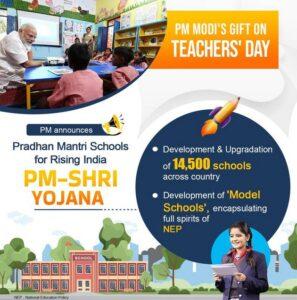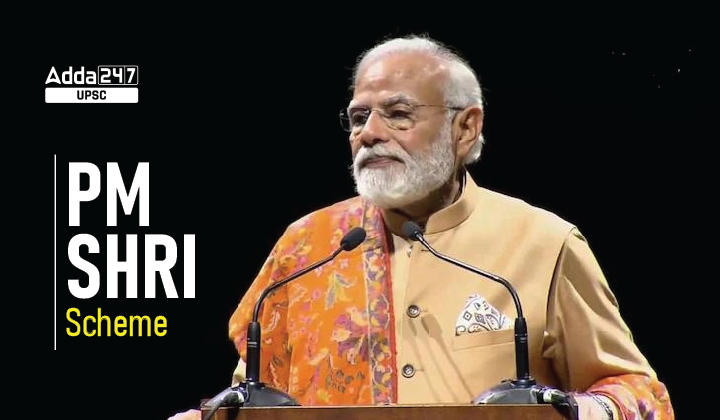Table of Contents
PM SHRI Scheme- Relevance for UPSC Exam
General Studies II- Health and Education.
In News
Prime Minister has announced that under the PM SHRI Scheme, as many as 14,500 schools will be “upgraded” across India to showcase the components of the National Education Policy, 2020.
What is the PM SHRI scheme?
- 14,500 schools across states and Union Territories will be redeveloped to reflect the key features of the NEP, 2020 under the centrally sponsored scheme known as PM SHRI Schools (PM Schools for Rising India).
- The plan was first discussed with the education ministers of states and UTs during a conference organized by the Ministry of Education in June at Gandhinagar in Gujarat.
- While there are exemplary schools like Navodaya Vidyalayas, Kendriya Vidyalayas, the PM SHRI will act as “NEP labs”.

Features of NEP in school education
- The NEP envisages a curricular structure and teaching style divided into various stages – foundational, preparatory, middle and secondary.
- The foundational years (pre-school and grades I, II) will involve play-based learning.
- At the preparatory level (III-V), light textbooks are to be introduced along with some formal classroom teaching. Subject teachers are to be introduced at the middle level (VI-VIII).
- The secondary stage (IX-XII) will be multidisciplinary in nature with no hard separation between arts and sciences or other disciplines.
How will PM SHRI schools be different from Kendriya Vidyalayas or Jawahar Navodaya Vidyalayas?
- Kendriya Vidyalayas or Jawahar Navodaya Vidyalayas come entirely under the Centre’s Ministry of Education and are fully funded by the Union government under Central Sector Schemes.
- While KVs largely cater to children of Union government employees posted in states and UTs, JNVs were set up to nurture talented students in rural parts of the country.
- In contrast, PM SHRI schools will be an upgrade of existing schools run by the Centre, states, UTs and local bodies.
- This essentially means that PM SHRI schools can either be KVs, JNVs, state government schools or even those run by municipal corporations.
Where will the PM SHRI schools come up?
- The Centre has not yet released the list of schools that have been chosen for this purpose though it has been announced that the PM SHRI schools will also “offer mentorship” to other schools in their vicinity.
- These schools will be equipped with modern infrastructure including labs, smart classrooms, libraries, sports equipment, art room etc.
- It shall also be developed as green schools with water conservation, waste recycling, energy-efficient infrastructure and integration of organic lifestyle in curriculum.
What is a Centrally Sponsored Scheme?
- A centrally sponsored scheme is one where the cost of implementation is likely to split in the 60:40 ratio among the Union government and the states/Union Territories.
- For instance, the mid-day meal scheme (PM Poshan) or the PM Awas Yojana are examples of centrally sponsored schemes.
- In the case of the Northeastern states, Himachal Pradesh, Uttarakhand, Jammu and Kashmir and UTs without legislatures, the Centre’s contribution can go up to 90 per cent.




 TSPSC Group 1 Question Paper 2024, Downl...
TSPSC Group 1 Question Paper 2024, Downl...
 TSPSC Group 1 Answer key 2024 Out, Downl...
TSPSC Group 1 Answer key 2024 Out, Downl...
 UPSC Prelims 2024 Question Paper, Downlo...
UPSC Prelims 2024 Question Paper, Downlo...




